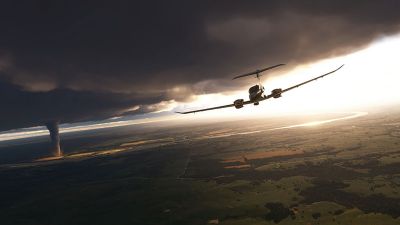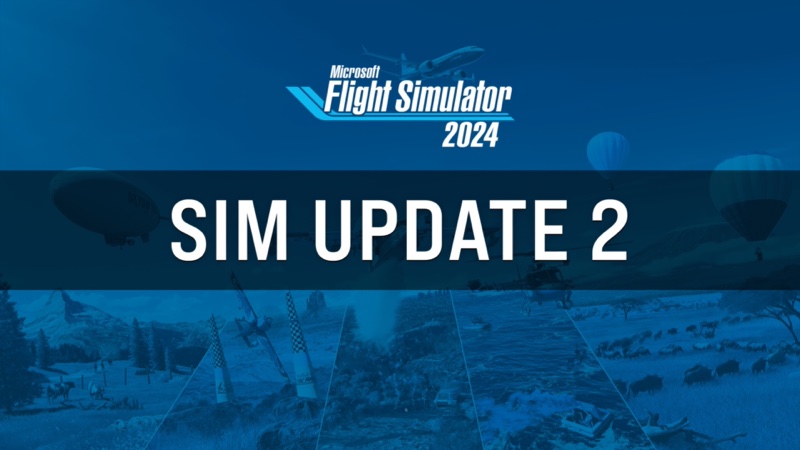
Microsoft Flight Simulator 2024: A Detailed Analysis
The all-new Microsoft Flight Simulator 2024 represents a substantial leap forward in real-time flight simulation, integrating cutting-edge…

Sim Update 2 (version 1.4.20.0) for Microsoft Flight Simulator 2024 significantly enhances performance and stability, refining flight models, avionics, and mission features. Pilots can expect smoother texture rendering, more robust career modes, advanced VR capabilities, and improved control mappings. Updated scenery and weather systems add realism, while SDK upgrades support richer third-party development. All told, it represents a sweeping upgrade addressing core user feedback and technical refinements.
Sim Update 2 (version 1.4.20.0) arrives with a keen emphasis on core optimization, boasting sizeable gains in frame pacing, loading efficiency, and overall application stability in both PC and Xbox environments. Among many under-the-hood changes, Microsoft overhauled the texture management system to eliminate incongruent rendering and reduce stuttering. The update also modifies rolling cache usage, making it more predictable and flexible for users who need to adjust it depending on system specifications and network conditions.
Additionally, the simulator now handles lost internet connections gracefully by limiting disruptions and implementing stronger fallback routines. These refinements aim to deliver steadier performance in crowded areas, especially when add-ons and live traffic are in play.
Below is the official Microsoft Flight Simulator 2024 release trailer.
A wide variety of airplanes and rotorcraft underwent extensive fixes and re-tuning. To illustrate, flight models were scrutinized for improved realism regarding takeoff roll, climb rates, and turbulence behavior. Pilots also receive an enhanced wear-and-tear feature on multiple aircraft, giving them cumulative brake damage, propeller stress, and fluid system simulation.
Meanwhile, the G1000, G3000, G5000, and other glass cockpit avionics have undergone code-level improvements to rectify display flickers and inaccurate sensor data. In practical terms, you’ll see fewer autopilot overshoots, more consistent flight plan transitions, and better integration with external flight plans or career missions. Those who favor older steam-gauge cockpits can expect sharper gauge animations and more reliable drone-camera interactions.
The new release significantly expands career gameplay. The mission system is now sturdier, with clearer objective markers, refined weather transitions, and more accurate credit rewards for tasks like firefighting or cargo transport. The entire “aircraft store” interface also benefits from better feedback: you’ll receive more prompting if you try to purchase aircraft that your profile lacks certification for.
Additionally, recurring issues in missions—like improperly recognized landings—are resolved. Rare crashes tied to group or employee transfers (in the career interface) have been reduced as well. From an operational standpoint, medevac missions and aerial construction missions incorporate extra dialogue and in-sim triggers to guide players through different steps more coherently.
Sim Update 2 addresses many VR ecosystem requests. Notably, the introduction of native quad-views Foveated Rendering can boost frame rates with minimal visual sacrifice, especially on high-resolution headsets. This advanced method adjusts how the scene is rendered in real time: the center receives high resolution while peripheral areas use optimized fidelity. Eye-tracking headsets further customize the visual field to match your gaze, offering both performance gains and sharper focus where it’s needed.
Developers also resolved UI conflicts that previously appeared when using certain VR controllers. The toolbar now remains fully interactable, even if you switch between controller-based gestures and a mouse pointer. Plus, the simulator’s mission steps now properly display VR-compatible icons, ensuring that you never have to awkwardly peek under a headset to remember which button is needed.
A robust set of control mapping improvements makes it easier to manage axis curves and action bindings. For instance, the newly introduced “THROTTLE IDLE” command sets all throttles to the idle detent, and you’ll find improved defaults for reverse thrust on certain hardware throttles. The once-cluttered control interface now includes a help section for each device, explaining how to interpret and adjust the input curves.
Likewise, official default profiles for popular sticks and pedals incorporate rotorcraft throttle logic, mitigating confusion over helicopter collective assignments. The UI can also display real-time device inputs so you can quickly see which button or axis is being recognized without leaving the sim.
A bevy of scenery improvements are worth noting. The shoreline ice effect now appears as realistic ice floes rather than blocky outlines, and lakes freeze under low temperatures for winter flying fans. Photogrammetry data has been refined for large cities, and terrain LOD transitions are smoother to minimize jarring pop-ins when flying at high or low altitudes.
Meanwhile, the simulator modifies the vegetation system to avoid abrupt biome transitions. You’ll see fewer pockets of mismatched forests, plus improved grass draw distance for bush flights. Many airports also benefit from fix-ups: runways no longer produce unusual bumps near threshold markers, and you shouldn’t see roads or traffic crossing runways in handcrafted or upgraded fields.
Efforts to boost live traffic synchronization are front and center. Improvements to AI spawning logic prevent aircraft from piling into the same gate or ignoring directional cues. This means real traffic data should more closely reflect real-world schedules with fewer bizarre taxi paths. Multiplayer sessions are also more stable—group invites now show explicit error messages if the session is full, and player-to-player synchronization is more robust to network hiccups.
On top of that, the weather engine addresses bugs around old METAR data cropping up unexpectedly. Pilots can now expect more accurate historic weather references and fewer radical jumps in conditions mid-flight. If you’re someone who needs certain METAR snapshots for flight planning, the sim updates weather data accordingly as you adjust date and time.
For content creators, DevMode includes new debugging windows for electricity systems, flight models, and advanced helicopter parameters. Visual Effects Editor enhancements let developers group-layer complex effects or apply partial node-group edits without tangling up unrelated assets. Downloading or sharing new projects feels more fluid with the reworked build process, which generates more detailed warnings if you have typos or incorrect parameters in config files.
The updated SimConnect and WASM library addresses issues around callback registration, preventing modules from crashing the sim if an event is triggered in quick succession. Overall, Microsoft is encouraging third-party add-on developers to integrate natively with 2024’s advanced features, ensuring better backward compatibility and a clearer upgrade path from MSFS 2020 packages.
From my perspective, this is one of the most sweeping sim updates I’ve encountered. Practically every aircraft you can think of has received some level of rework, from minor cockpit tooltip fixes to elaborate flight model corrections. As an enthusiast who loves a wide mix of general aviation and rotorcraft, I find the new wear-and-tear detail especially delightful—it lends a sense of authenticity and risk management you’d expect from real-world flying.
Of course, large updates can bring along transitional quirks, so it’s smart to keep your Community folder light or move add-ons temporarily until you’re confident everything is stable. The dev team has clearly aligned many of these fixes with user feedback, hoping to iron out major stumbling blocks before the next iteration of expansions or new content.
All told, Sim Update 2 arrives with hundreds of additional minor improvements and bug fixes that we simply can’t list here. To dive deeper into the release notes—especially for those who want the line-by-line breakdown of aircraft changes—head to the official Microsoft Flight Simulator 2024 documentation. Be prepared for a lengthy read!
Before loading into the sim, remember to update your NVIDIA Game Ready Driver (version 576.40 or later) if you have an NVIDIA GPU. This is strongly recommended to avoid potential performance drops or random crashes introduced by older drivers.
We’d love to hear how Sim Update 2 is running on your system. Have you noticed improvements in frame rate or loading transitions? Is there a particular aircraft fix that stands out most to you? Drop a comment below and share your experiences, any hidden gems you’ve uncovered, or possible suggestions for future roadmap updates. Your feedback is always welcome!
Upgrade Microsoft Flight Simulator, FSX, P3D & X-Plane in minutes with our curated file library packed with aircraft, scenery, liveries, and utilities.
Ready to upgrade your hangar?
Browse the free file library
0 comments
Leave a Response